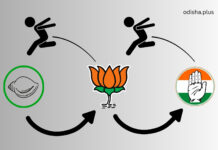Trailokya Jena
The abolition of Zamindari enacted soon after independence was probably considered enough by government to liberate farmers.

The extreme food shortages of the 1950s and 60s prompted certain interventions on the production side of which the Jai Kishan movement of Shashtri ji was most notable followed to some extent by Indira Gandhi’s legislation against rural indebtedness. While these measures attempted to address production side of farming, precious little was done to redress the supply/marketing side. The measure of national apathy went to the extent of farm distress disappearing from quality literature post independence. Even quality cinema, the other indicator of social concern, veered away from farmers’ distress after the heights of Do Bigha Zameen(1953) and Mother India(1957).
The Naxal Movement that started from paddy fields of Naxal Bari quickly moved out to urban industrial landscape. Nothing would better indicate the neglect of farmers’ lives in modern India than the absence of representative literature of stature like say The Good Earth trilogy from China and The Grapes of Wrath from heartland America, punned as subtitle of the blog here for reasons that’d be discussed later. Meanwhile we have to live with the continuous hijacking of farmers’ agenda by Political Parties, urban based farmers organisations, genuine and agenda ridden NGOs, commercial lobbies, agri-based MNEs and all sorts of out of work Leftist free loaders and most of all government that threatens to double farmers’ income in short block of years. After all these years of drifting we now have three legislations in process which promise to liberate the farmers comparable to the liberation of industry in 1991. Time to discuss those legislations which were brought in as ordinances during the scary silence of extreme lockdown days.
In India we revel at giving long, exaggerated titles to legislations as if such hyperbolic names would rid us of all maladies. For the sake of simplicity I’d avoid the long titles going by the essence of those legislation first to discuss the features and objectives of those and then going for their critical merit and the various objections raised against it. Discussion in Part-I explained how governments, instead of allowing farmers to grow, have always stopped them from growing. The markets have never worked in the past for the farmers as they have consistently been dis-intermediated from it. These three legislations working together aim, in the eyes of the government, to restore the farmers to the markets.

The first, Farmers Produce Trade and Commerce Bill deals with the APMC monopoly aiming at establishing one nation one market by removing all restrictions on farmers to sell their produce to whomsoever they like and wherever they like. The problem with our country is that any alleviation measure for the public is quickly converted by bureaucracy and intermediate interests into an ingenious cash machine. Thus the APMC once established to ensure farmers getting fair price for their produce turned out to be monopolies of inefficiency with cartelisation of middlemen and rampant corruption. The territorial limit it placed on local farmers killed their freedom to trade freely. This bill allows the farmers freedom to sell their produce at any place- at their houses, on the roads, at the traders, in side or out side their States including electronic trading. It also allows buyers to buy outside APMC markets without license or payment of fees.
The second Bill, Farmers Agreement on Price Assurance, deals with the mechanism of contract farming where buyers enter into agreement with farmers on assured price and quantity for the produce which aims at removal of farmers’ risk and uncertainty over selling. Under this law farmers are empowered to directly engage with processors, wholesalers, aggregators, retailers or exporters thus eliminating intermediaries to realise maximum price for their produce. It makes the buyers responsible for providing all necessary enablers to the farmers for cropping and provides dispute settlement mechanism at State governments level. The minimum period of agreement runs one crop season or one completed cycle of livestock.
The third Bill, Essential Commodities Amendment Bill, does away with stock limits for agricultural products to be imposed only under extraordinary circumstances in case of certain emergencies. It further stipulates that imposition of stock limits to be linked to price rise. The rationale here is to enable market buyers to procure agricultural produce from the farmers without restriction of quantity which would relieve both farmers and the government from the costly burden of storage. It is a direct corollary to the second Bill to allow the buyers for bulk contract with farmers without fear of storage restrictions.
In India you need muscle to control the mob when implementing reforms. The moment you try to disturb the established order you’ll not only be pushed back by vested interests but will definitely get media lynched. In our chaotic democracy the basic hypocrisy of all political parties is the truth that politicians would clean only as much as it would benefit them politically. It is practically impossible to build bipartisan or multipartisan consensus in Indian politics as often seen in America. These days even highly emotive and patriotic issues like war against enemies fail to find consensus. These Bills are already meeting with the kind of emotional hysteria at political level as did the Reform process of 1991. The Parties often pushing for measures in power would routinely oppose it when in opposition as BJP did to Congress led GST and what Congress is now doing with pretty much everything. Parties signing the Ordinance proposals would oppose it later at legislation stage. Parties would demand prior consultations with them and with States but once there you’d enter a political cul de sac indefinitely.
Without bothering much about the conduct of political parties let us examine the major detractors and spoilers. The prime force of continuity of all dated and moribund policies is the Congress, desperate to grab control simultaneously over opposite forces like market and farmers. They wouldn’t hesitate to backtrack from their own manifesto on removing restrictions in market operation. They have tasted success already by opposing the Land Acquisition Bill of 2015 preventing facilitation of industry effectively blocking manufacturing activities which would otherwise absorb surplus farm labour substantially. Their vicious campaign against Modi government as anti farmer ‘suit boot ki sarkar‘ succeeded not only in derailment of industrial expansion but also forced Modi to the back off and become more Congress than Congress in costly welfarism.
Congress Party is like a hospital promising each patient a ventilator rather than effective diagnosis and cure. They are time warped in subsidy and loan waiver. Regional parties won’t jeopardise their stranglehold on power built on years of freebie distribution as seen with Navin Patnaik government in my home State. The Left live in a different India and fortunately don’t matter much in present context other than scaring people through their Union saying private sector is taking over business of farming, then your land. They would work out the Grapes of Wrath scenario before the farmers scaring them with the extreme destitution and hopelessness of Steinbeck. These may be unfounded but such motivated propaganda is what politics is all about. They unite with the Congress to shout against crony capitalism while espousing all along their equally harmful crony socialism.
There is a solid block of middlemen called Adthiyas(there are 28,000 of them in Punjab alone) holding great stake in the prevailing system. They earn substantial commission on transactions and keep the regulatory agencies and local politicians sufficiently greased. The supply chains from the farming field to the consumers’ bags pass through several tollgates that steadily add to the value of produce to make it jump from two rupees to fifty in no time. I happened to be based in Kolkata when TMC came to power and within three months the commodity prices skyrocketed due to change of guard at each point. Telegraph newspaper published a full front page diagram of the travails of grains and vegetables from the field to retail market with the addition to the price of each item at every point(my attempt to retrieve that edition from their web archive didn’t succeed).
Bhindi sold by farmers for one rupee ultimately became 50(an astronomic price for the time in the traditionally cheap marketplace of Kolkata) for the consumers. The vested interests who pocketed the difference included village level party leader, local panchayat officials, policemen, district civil authorities, city council office holders, market union leaders and party goons at large practically every where on the route. And most of these looters were erstwhile CPM affiliates who had recently changed loyalties to TMC. The point about it is irrespective of change in Party in power the toll collectors are permanent! The life of a farmer in this hell is like the curvy struggle of a water snake trying to swim across a fast running stream.
Yet there are genuine concerns in the whole scheme pushed by the government. What if the market offers a price less than the MSP, or worse still if no buyers for the produce at all? This seems to be the most genuine concern of the Opposition. The promise of the government to continue with MSP sound hollow in absence of legal guarantee. There is a sticky situation here as the free market would certainly lower the procurement price mostly because of the enormous stock accumulated by the government through MSP led public procurement regime. To continue with the process would surely sabotage the free market. The government must find a sweet spot to tackle this situation. Besides government has to find a way to provide and educate farmers, especially those who are not tech savvy, on market information.
Then contract farming would throw up multiple challenges some of which had already been experienced in pilots like Pepsi’s venture on tomato farming and potato farming in Bengal. What if the buyer having contracted fails to buy at harvest time or having bought fails to pay for reasons including bankruptcy? It may so happen that a particular produce would command higher than contract price at harvest which would prompt farmers to disregard the contract by selling in open market. The regulatory mechanism created to tackle such scenario lean heavily on government machinery which can not be trusted as it would certainly get influenced by business rather than farmers.

Two great works in world literature from opposite ends of the world in every sense represent the finest depiction of farmers’ distress in modern times. One is The Good Earth, the first of a trilogy by Pearl S Buck(1931), centred in rural China during the upheaval of Civil War, Japanese occupation and Mao’s Long March. The other is The Grapes of Wrath(1939), John Steinbeck’s chilling story of an uprooted rural Oklahoma farmer family’s futile journey through the farming heartland of America in search of livelihood in the farming riches of heartless Depression era California. The fact that we have no such literature post 1950s in India(to the best of my knowledge of contemporary literature in regional languages) should tell us the truth about our lack of concern for farmers problems.
Most readers read The Good Earth as a stand alone book oblivious of the continuing journey of the Wang family from extreme poverty of rural China to their intermediate prosperity during the Kuomintang period in the second book Sons and later the youngest son’s journey to the West, presumably America, to close the trilogy in A House Divided exploring the transition from Chinese collectivism to western individualism. Grapes of Wrath on the other hand exposes the harshness of corporate take over of farming in Depression era America uprooting farmers from their land to become migrant farm workers and sacrificial pawns in prosperous California. Between them these two books portray, from extreme ends of East and West, the changing realities of farmers in a fast modernising world exposing the innate violence social Darwinism in which better adapted humans replace those less able to cope. T
he farmers’ situation in these contrasting worlds pose formidable to challenge to policy makers for neutralising the innate Darwinian violence in order to construct a society stable enough to allow the weak and the poor to adapt and grow to catch up with the rest. However, our politicians and opinion makers fail to see beyond their noses while continuing to manipulate the farmers for their own need. No politician shall risk losing their present voters, the rural poor from the farmlands, for building a rich future for their impoverished children who would vote for someone else at their time. The poor for themselves are neither prepared nor persuaded to sacrifice their present like old man Wang for the future of his sons as in Pearl Buck trilogy. Instead all our politicians would prefer to make examples of the Joad family of Grapes of Wrath to scare voters of corporate takeover of their land and livelihood. They won’t tell you about the prosperity of present China built on the hard work of the Wangs or about the comfort of present America built on the sacrifice of the Joads.
(The author has a Masters in Liberal Arts and an MBA from Sydney. He also worked for the Indian Revenue Service in Kolkata, Mumbai and Delhi. Views are personal.)





















